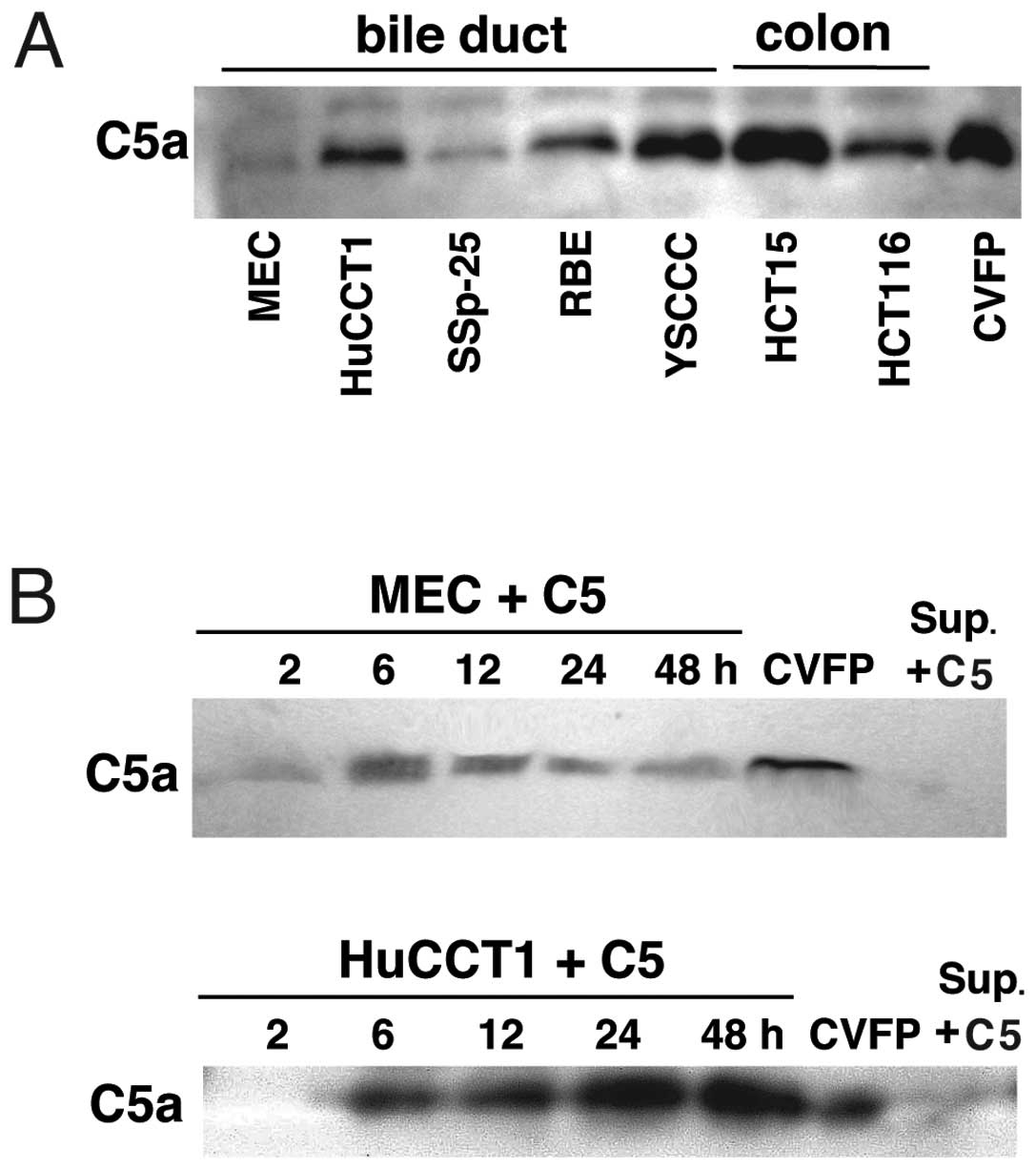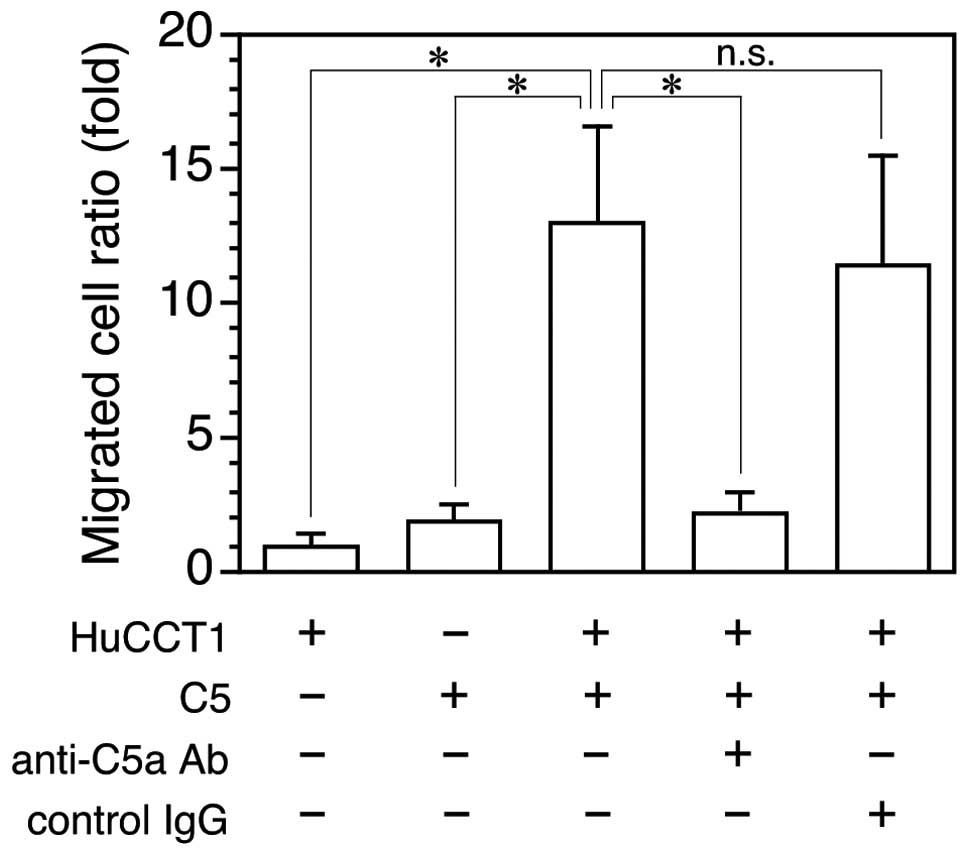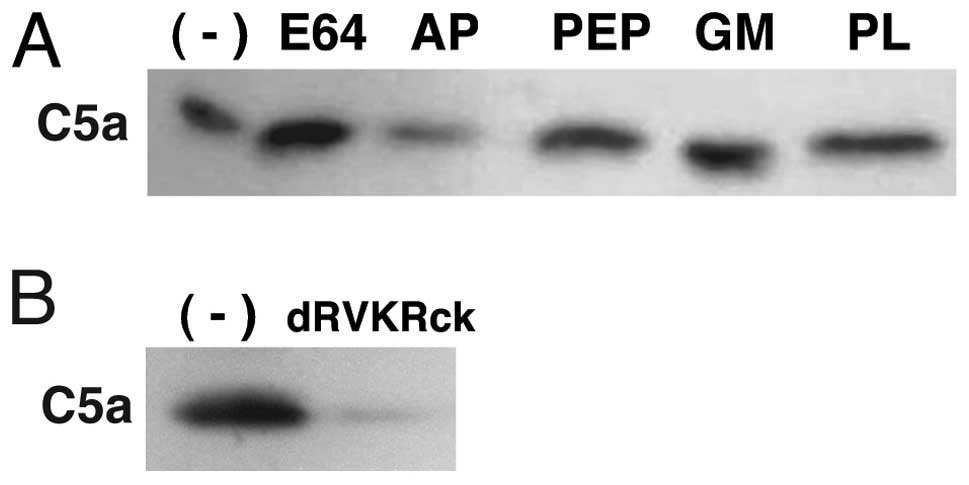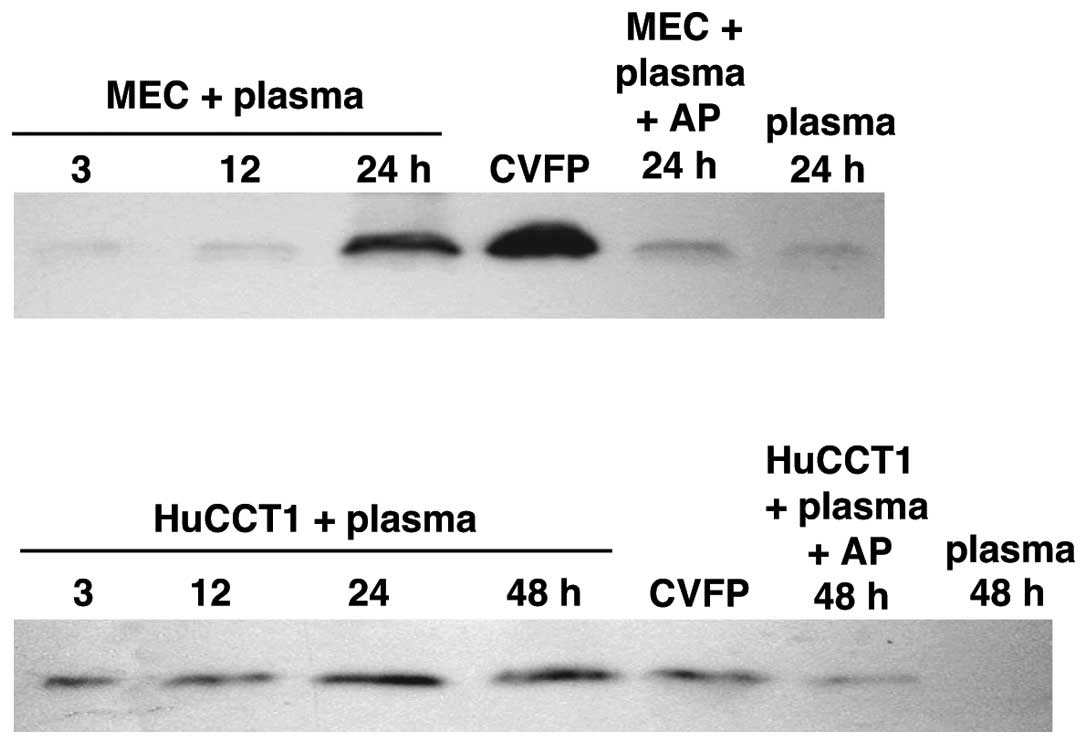|
1
|
Ricklin D, Hajishengallis G, Yang K and
Lambris JD: Complement: a key system for immune surveillance and
homeostasis. Nat Immunol. 11:785–797. 2010. View Article : Google Scholar : PubMed/NCBI
|
|
2
|
Niculescu F, Rus HG, Retegan M and Vlaicu
R: Persistent complement activation on tumor cells in breast
cancer. Am J Pathol. 140:1039–1043. 1992.PubMed/NCBI
|
|
3
|
Bjørge L, Hakulinen J, Vintermyr OK, Jarva
H, Jensen TS, Iversen OE and Meri S: Ascitic complement system in
ovarian cancer. Br J Cancer. 92:895–905. 2005.
|
|
4
|
Markiewski MM, DeAngelis RA, Benencia F,
Ricklin-Lichtsteiner SK, Koutoulaki A, Gerard C, Coukos G and
Lambris JD: Modulation of the antitumor immune response by
complement. Nat Immunol. 9:1225–1235. 2008. View Article : Google Scholar : PubMed/NCBI
|
|
5
|
Corrales L, Ajona D, Rafail S, et al:
Anaphylatoxin C5a creates a favorable microenvironment for lung
cancer progression. J Immunol. 189:4674–4683. 2012. View Article : Google Scholar : PubMed/NCBI
|
|
6
|
Müller-Eberhard HJ: Molecular organization
and function of the complement system. Annu Rev Biochem.
57:321–347. 1988.
|
|
7
|
Yamakawa M, Yamada K, Tsuge T, Ohrui H,
Ogata T, Dobashi M and Imai Y: Protection of thyroid cancer cells
by complementregulatory factors. Cancer. 73:2808–2817. 1994.
View Article : Google Scholar : PubMed/NCBI
|
|
8
|
Niehans GA, Cherwitz DL, Staley NA, Knapp
DJ and Dalmasso AP: Human carcinomas variably express the
complement inhibitory proteins CD46 (membrane cofactor protein),
CD55 (decay-accelerating factor), and CD59 (protectin). Am J
Pathol. 149:129–142. 1996.
|
|
9
|
Jurians K, Ziegler S, Garcia-Schüller H,
Kraus S, Bohana-Kashtan O, Fishelson Z and Kirschfink M: Complement
resistance of tumor cells: basal and induced mechanisms. Mol
Immunol. 36:929–939. 1999. View Article : Google Scholar : PubMed/NCBI
|
|
10
|
Morgan J, Spendlove I and Durrant L: The
role of CD55 in protecting the tumour environment from complement
attack. Tissue Antigens. 60:213–223. 2002. View Article : Google Scholar : PubMed/NCBI
|
|
11
|
Gancz D and Fishelson Z: Cancer resistance
to complement-dependent cytotoxicity (CDC): problem-oriented
research and development. Mol Immunol. 46:2794–2800. 2009.
View Article : Google Scholar : PubMed/NCBI
|
|
12
|
Liu J, Miwa T, Hilliard B, Chen Y, Lambris
JD, Wells AD and Song WC: The complement inhibitory protein DAF
(CD55) suppresses T cell immunity in vivo. J Exp Med. 201:567–577.
2005. View Article : Google Scholar : PubMed/NCBI
|
|
13
|
Mikesch JH, Buerger H, Simon R and Brandt
B: Decay-accelerating factor (CD55): a versatile acting molecule in
human malignancies. Biochim Biophys Acta. 1766:42–52.
2006.PubMed/NCBI
|
|
14
|
Guo RF and Ward PA: Role of C5a in
inflammatory responses. Annu Rev Immunol. 23:821–852. 2005.
View Article : Google Scholar : PubMed/NCBI
|
|
15
|
Markiewski MM and Lambris JD: The role of
complement in inflammatory diseases from behind the scenes into the
spotlight. Am J Pathol. 171:715–727. 2007. View Article : Google Scholar : PubMed/NCBI
|
|
16
|
Nozaki M, Raisler BJ, Sakurai E, et al:
Drusen complement components C3a and C5a promote choroidal
neovascularization. Proc Natl Acad Sci USA. 103:2328–2333. 2006.
View Article : Google Scholar : PubMed/NCBI
|
|
17
|
Gerard NP and Gerard C: The chemotactic
receptor for human C5a anaphylatoxin. Nature. 349:614–617. 1991.
View Article : Google Scholar : PubMed/NCBI
|
|
18
|
Nitta H, Wada Y, Kawano Y, et al:
Enhancement of human cancer cell motility and invasiveness by
anaphylatoxin C5a via aberrantly expressed C5a receptor (CD88).
Clin Cancer Res. 19:2004–2013. 2013. View Article : Google Scholar : PubMed/NCBI
|
|
19
|
Huber-Lang M, Sarma JV, Zetoune FS, et al:
Generation of C5a in the absence of C3: a new complement activation
pathway. Nat Med. 12:682–687. 2006. View
Article : Google Scholar : PubMed/NCBI
|
|
20
|
Nitta H, Imamura T, Wada Y, Irie A,
Kobayashi H, Okamoto K and Baba H: Production of C5a by ASP, a
serine protease released from Aeromonas sobria. J Immunol.
181:3602–3608. 2008. View Article : Google Scholar : PubMed/NCBI
|
|
21
|
Huber-Lang M, Younkin EM, Sarma JV, et al:
Generation of C5a by phagocytic cells. Am J Pathol. 161:1849–1859.
2002. View Article : Google Scholar : PubMed/NCBI
|
|
22
|
Albini A, Iwamoto Y, Kleinman HK, Martin
GR, Aaronson SA, Kozlowski JM and McEwan RN: A rapid in vitro assay
for quantitating the invasive potential of tumor cells. Cancer Res.
47:3239–3245. 1987.PubMed/NCBI
|
|
23
|
Kobayashi H, Utsunomiya H, Yamanaka H, Sei
Y, Katunuma N, Okamoto K and Tsuge H: Structural basis for the
kexin-like serine protease from Aeromonas sobria as
sepsis-causing factor. J Biol Chem. 284:27655–27663. 2009.
View Article : Google Scholar : PubMed/NCBI
|
|
24
|
Nitta H, Kobayashi H, Irie A, Baba H,
Okamoto K and Imamura T: Activation of prothrombin by ASP, a serine
protease released from Aeromonas sobria. FEBS Lett.
581:5935–5939. 2007. View Article : Google Scholar : PubMed/NCBI
|
|
25
|
Tian S and Jianhua W: Comparative study of
the binding pockets of mammalian proprotein convertases and its
implications for the design of specific small molecule inhibitors.
Int J Biol Sci. 6:89–95. 2010. View Article : Google Scholar
|
|
26
|
Pintigny D and Dachary-Prigent J:
Aprotinin can inhibit the proteolytic activity of thrombin. A
fluorescence and enzymatic study. Eur J Biochem. 207:89–95. 1992.
View Article : Google Scholar : PubMed/NCBI
|
|
27
|
Maeda H, Fang J, Inutsuka T and Kitamoto
Y: Vascular permeability enhancement in solid tumor: various
factors, mechanisms involved and its implications. Int
Immunopharmacol. 3:319–328. 2003. View Article : Google Scholar : PubMed/NCBI
|
|
28
|
Angliker H, Wilkstrom P, Shaw E, Brenner C
and Fuller RS: The synthesis of inhibitors for processing
proteinases and their action on the Kex2 proteinase of yeast.
Biochem J. 293:75–81. 1993.PubMed/NCBI
|
|
29
|
DiScipio RG, Smith CA, Müller-Eberhard HJ
and Hugli TE: The activation of human complement C5 by a fluid
phase C5 convertase. J Biol Chem. 258:10629–10636. 1983.PubMed/NCBI
|
|
30
|
Antonini E, Ascenzi P, Bolognesi M, Gatti
G, Guameri M and Menegatti E: Interaction between serine
(pro)enzymes, and Kazal and Kunitz inhibitors. J Mol Biol.
165:543–558. 1983. View Article : Google Scholar : PubMed/NCBI
|
|
31
|
Angliker H: Synthesis of tight binding
inhibitors and their action on the proprotein-processing enzyme
furin. J Med Chem. 38:4014–4018. 1995. View Article : Google Scholar : PubMed/NCBI
|
|
32
|
Szabo R and Bugge TH: Membrane-anchored
serine proteases in vertebrate cell and developmental biology. Annu
Rev Cell Dev Biol. 27:213–235. 2011. View Article : Google Scholar : PubMed/NCBI
|
|
33
|
Condeelis J and Pollard JW: Macrophages:
obligate partners for tumor cell migration, invasion, and
metastasis. Cell. 124:263–266. 2006. View Article : Google Scholar : PubMed/NCBI
|
|
34
|
van der Bij GJ, Oosterling SJ, Meijer S,
Beelen RH and van Egmond M: The role of macrophages in tumor
development. Cell Oncol. 27:203–213. 2005.PubMed/NCBI
|
|
35
|
Crowther M, Brown NJ, Bishop ET and Lewis
CE: Microenvironmental influence on macrophage regulation of
angiogenesis in wounds and malignant tumors. J Leukoc Biol.
70:478–490. 2001.PubMed/NCBI
|
|
36
|
Nozawa H, Chiu C and Hanahan D:
Infiltrating neutrophils mediate the initial angiogenic switch in a
mouse model of multistage carcinogenesis. Proc Natl Acad Sci USA.
103:12493–12498. 2006. View Article : Google Scholar : PubMed/NCBI
|


















